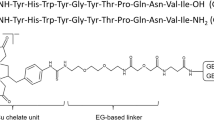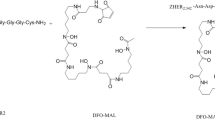Abstract
Purpose
Cotinine has optimal characteristics as a hapten for pre-targeted radioimmunotherapy (PRIT). This study was performed to evaluate the applicability of cotinine/anti-cotinine antibody to PRIT.
Methods
We developed and prepared a tandem, single-chain, variable fragment Fc fusion protein [tandem single-chain variable fragment (scFv) Fc fusion protein] that is reactive to both human epidermal growth factor receptor 2 (Her2) and cotinine. Its simultaneous reactivity to Her2 and cotinine was tested in an enzyme-linked immunosorbent assay (ELISA) and two radioimmunoassays (RIA) employing Her2-coated RIA tubes and a Her2-overexpressing cell line. For in vivo imaging, mice bearing Her2-positive tumors were injected with a mixture of tandem scFv Fc fusion and 125I-cotinine-conjugated histidine dipeptide (125I-cotinine peptide). After a delay, 125I-cotinine peptide was injected again.
Results
ELISA and RIA results showed that tandem scFv Fc fusion protein successfully bound to both Her2 and cotinine. In single-photon emission computed tomography (SPECT), the complex of tandem scFv Fc fusion protein and 125I-cotinine peptide was localized to Her2-positive tumor xenografts in mice 4 h after the first injection. Enhanced radioactivity at the site of the Her2-positive tumor lesion was monitored 1 h after the second injection.
Conclusions
With these findings, we conclude that the tandem scFv Fc fusion protein and cotinine hapten system have the potential to be applied in PRIT.





Similar content being viewed by others
References
Anderson K, Lai ZH, McDonald OB, Stuart JD, Nartey EN et al (2009) Biochemical characterization of GSK1070916, a potent and selective inhibitor of Aurora B and Aurora C kinases with an extremely long residence time. Biochem J 420:259–265
Baxter AB, Melnikoff S, Stites DP, Brasch RC (1991) Immunogenicity of gadolinium-based contrast agents for magnetic-resonance-imaging—induction and characterization of antibodies in animals. Invest Radiol 26:1035–1040
Behr TM, Gotthardt M, Becker W, Behe M (2002) Radioiodination of monoclonal antibodies, proteins and peptides for diagnosis and therapy—a review of standardized, reliable and safe procedures for clinical grade levels kBq to GBq in the Gottingen/Marburg experience. Nuklearmedizin-Nucl Med 41:71–79
Boerman OC, van Schaijk FG, Oyen WJG, Corstens FHM (2003) Pretargeted radioimmunotherapy of cancer: progress step by step. J Nucl Med 44:400–411
Bowman Edward R, Herbert McKennis J (1962) Studies on the metabolism of (−)-cotinine in the human. J Pharmacol Exp Ther 135:306
Carter P, Presta L, Gorman CM, Ridgway JBB, Henner D et al (1992) Humanization of an Anti-P185her2 antibody for human cancer-therapy. Proc Natl Acad Sci USA 89:4285–4289
Chang CH, Sharkey RM, Rossi EA, Karacay H, McBride W et al (2002) Molecular advances in pretargeting radioimunotherapy with bispecific antibodies. Mol Cancer Ther 1:553–563
Chang CH, Rossi EA, Goldenberg DM (2007) The dock and lock method: a novel platform technology for building multivalent, multifunctional structures of defined composition with retained bioactivity. Clin Cancer Res 13:5586s–5591s
Chatal JF, Davodeau F, Cherel M, Barbet J (2009) Different ways to improve the clinical effectiveness of radioimmunotherapy in solid tumors. J Cancer Res Ther 5:36–40
Colombo P, Siccardi AG, Paganelli G, Magnani P, Songini C et al (1996) Three-step immunoscintigraphy with anti-chromogranin a monoclonal antibody in tumours of the pituitary region. Eur J Endocrinol 135:216–221
Fritz T, Unger E, Wilsonsanders S, Ahkong QF, Tilcock C (1991) Detailed toxicity studies of liposomal gadolinium-DTPA. Invest Radiol 26:960–968
Gautherot E, Le Doussal JM, Bouhou J, Manetti C, Martin M et al (1998) Delivery of therapeutic doses of radioiodine using bispecific antibody-targeted bivalent haptens. J Nucl Med 39:1937–1943
Goldenberg DM, Rossi EA, Sharkey RM, McBride WJ, Chang CH (2008) Multifunctional antibodies by the dock-and-lock method for improved cancer Imaging and therapy by pretargeting. J Nucl Med 49:158–163
Jakubowski H (2002) Understanding biochemical dissociation constants: a temporal perspective. J Chem Educ 79:968–971
Karacay H, Brard PY, Sharkey RM, Chang CH, Rossi EA et al (2005) Therapeutic advantage of pretargeted radioimmunotherapy using a recombinant bispecific antibody in a human colon cancer xenograft. Clin Cancer Res 11:7879–7885
Kim I, Huestis MA (2006) A validated method for the determination of nicotine, cotinine, trans-3′-hydroxycotinine, and norcotinine in human plasma using solid-phase extraction and liquid chromatography-atmospheric pressure chemical ionization-mass spectrometry. J Mass Spectrom 41:815–821
Knox SJ, Goris ML, Tempero M, Weiden PL, Gentner L et al (2000) Phase II trial of yttrium-90-DOTA-biotin pretargeted by NR-LU-10 antibody/streptavidin in patients with metastatic colon cancer. Clin Cancer Res 6:406–414
Kosmas C, Snook D, Gooden CS, Courtenayluck NS, Mccall MJ et al (1992) Development of humoral immune-responses against a macrocyclic chelating agent (Dota) in cancer-patients receiving radioimmunoconjugates for imaging and therapy. Cancer Res 52:904–911
Kosmas C, Maraveyas A, Gooden CS, Snook D, Epenetos AA (1995) Anti-chelate antibodies after intraperitoneal yttrium-90-labeled monoclonal-antibody immunoconjugates for ovarian-cancer therapy. J Nucl Med 36:746–753
Massarweh S, Osborne CK, Jiang S, Wakeling AE, Rimawi M et al (2006) Mechanisms of tumor regression and resistance to estrogen deprivation and fulvestrant in a model of estrogen receptor-positive, HER-2/neu-positive breast cancer. Cancer Res 66:8266–8273
Meyer DCC, Port M, Barbotin V, Bonnemain B (2010) Process for preparing a pharmaceutical formulation of contrast agents. EP2242515 A2
Milenic DE, Brady ED, Brechbiel MW (2004) Antibody-targeted radiation cancer therapy. Nat Rev Drug Discov 3:488–498
Moran VE (2012) Cotinine: beyond the expected, more than a biomarker of tobacco consumption. Frontiers Pharmacol 3:1–9
Olafsen T, Tan GJ, Cheung CW, Yazaki PJ, Park JM et al (2004) Characterization of engineered anti-pI85(HER-2) (scFv-C(H)3)(2) antibody fragments (minibodies) for tumor targeting. Protein Eng Des Sel 17:315–323
Orcutt KD, Nasr KA, Whitehead DG, Frangioni JV, Wittrup KD (2011) Biodistribution and clearance of small molecule hapten chelates for pretargeted radioimmunotherapy. Mol Imag Biol 13:215–221
Paganelli G, Riva P, Deleide G, Clivio A, Chiolerio F et al. (1988) Invivo labeling of biotinylated monoclonal-antibodies by radioactive avidin—a strategy to increase tumor radiolocalization. Int J Cancer 2:121–125
Park S, Lee DH, Park JG, Lee YT, Chung J (2010) A sensitive enzyme immunoassay for measuring cotinine in passive smokers. Clin Chim Acta 411:1238–1242
Park S, Hwang D, Chung J (2012) Cotinine-conjugated aptamer/anti-cotinine antibody complexes as a novel affinity unit for use in biological assays. Exp Mol Med 44:554–561
Riah O, Dousset JC, Courriere P, Stigliani JL, Baziard-Mouysset G et al (1999) Evidence that nicotine acetylcholine receptors are not the main targets of cotinine toxicity. Toxicol Lett 109:21–29
Rossi EA, Goldenberg DM, Cardillo TM, McBride WJ, Sharkey RM et al (2006) Stably tethered multifunctional structures of defined composition made by the dock and lock method for use in cancer targeting. Proc Natl Acad Sci USA 103:6841–6846
Sharkey RM, Karacay H, Chang CH, McBride WJ, Horak ID et al (2005) Improved therapy of non-Hodgkin’s lymphoma xenografts using radionuclides pretargeted with a new anti-CD20 bispecific antibody. Leukemia 19:1064–1069
Sharkey RM, Rossi EA, McBride WJ, Chang CH, Goldenberg DM (2010) Recombinant bispecific monoclonal antibodies prepared by the dock-and-lock strategy for pretargeted radioimmunotherapy. Semin Nucl Med 40:190–203
Watanabe N, Goodwin DA, Meares CF, Mctigue M, Chaovapong W et al (1994) Immunogenicity in rabbits and mice of an antibody-chelate conjugate—comparison of (S) and (R) macrocyclic enantiomers and an acyclic chelating agent. Cancer Res 54:1049–1054
Acknowledgments
This work was supported by a grants from the following programs: Pioneer Research Center Program through the National Research Foundation of Korea funded by the Ministry of Science, ICT and Future Planning (2013-009119); Basic Science Research Program through the National Research Foundation of Korea (NRF) funded by the Ministry of Education (2009-0093820); and the National Research Foundation of Korea (NRF) funded by the Korean government (MSIP) (2011-0030119).
Conflict of interest
None.
Author information
Authors and Affiliations
Corresponding author
Additional information
Soomin Yoon and Yun-Hee Kim have contributed equally to this study.
Rights and permissions
About this article
Cite this article
Yoon, S., Kim, YH., Kang, S.H. et al. Bispecific Her2 × cotinine antibody in combination with cotinine–(histidine)2–iodine for the pre-targeting of Her2-positive breast cancer xenografts. J Cancer Res Clin Oncol 140, 227–233 (2014). https://doi.org/10.1007/s00432-013-1548-4
Received:
Accepted:
Published:
Issue Date:
DOI: https://doi.org/10.1007/s00432-013-1548-4




